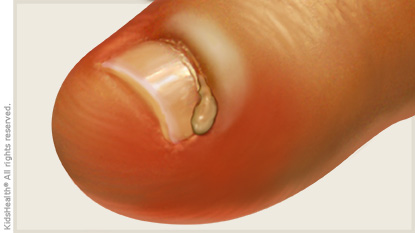Paronychia
Article Translations: (Spanish)
What Is Paronychia?
Paronychia (pronounced: pair-uh-NIK-ee-uh) is an infection of the skin around a fingernail or toenail. The infected area can get swollen, red, and painful. Sometimes a pus-filled blister may form.
Most of the time, paronychia is no big deal and can be treated at home. In rare cases, the infection can spread to the rest of the finger or toe. When that happens, it can lead to bigger problems that may need a doctor's help.
You're not likely to get paronychia in a toe (unless you have an ingrown toenail). But fingernail paronychia is one of the most common hand infections there is

What Causes Paronychia?
Paronychia usually happens when the skin around a person's nail is irritated or injured. When the skin around the nail is damaged, germs can get in and cause an infection. These germs can be bacteria (causing bacterial paronychia) or fungi (causing fungal paronychia).
Common paronychia causes include:
- biting or pulling off a hangnail
- frequent sucking on a finger
- clipping a nail too short or trimming the cuticle (the skin around the sides and bottom of the nail)
- getting manicures
- having hands in water a lot (as from a job washing dishes in a restaurant)
Some people get paronychia infections after a manicure or using from chemicals in the glue used with artificial nails. Certain health conditions (like diabetes) also can make paronychia more likely. And if your hands are in water a lot (if you wash dishes at a restaurant, for example), that ups the chances of getting paronychia.
What Are the Signs of Paronychia?
Chances are, if you have paronychia, it will be easy to recognize. There will be an area of skin around a nail that is painful and tender when you touch it. The area probably will be red and swollen and feel warm. You may see a pus-filled blister.
If the paronychia has been there a long time, the nail may turn a different color. It might not be its usual shape or might look as if it's coming away from the nail bed.
What Should You Do?
If paronychia is mild and hasn't started to spread beyond the fingernail, you can probably treat it at home. Soak the infected nail in warm water for 20 minutes a few times a day. The infection will probably heal on its own in a few days.
If paronychia doesn't get better after a week or so, call your doctor. You'll want to call a doctor right away if you have an abscess (a pus-filled area in the skin or under the nail) or if it looks like the infection has spread beyond the area of the nail.
If paronychia becomes severe and you don't see a doctor, infection can spread through the finger or toe and move into the rest of the body. Luckily, this is very rare.
What Do Doctors Do?
Usually, a doctor or nurse practitioner will be able to diagnose paronychia just by examining the infected area. In some cases, a doctor may take a pus sample to be examined in a laboratory to determine what type of germ is causing the infection.
If you have diabetes, let your doctor know if you notice any signs of paronychia, even if it seems mild.
Don't try to puncture or cut into an abscess yourself. Doing that can lead to a more serious infection or other complications. The doctor may need to drain the abscess and possibly prescribe antibiotic medications to treat the infection. Once an abscess is treated, the finger or toe almost always heals very quickly.
If someone has fungal paronychia, a doctor may prescribe antifungal creams, lotions, or other medicines.
Can Paronychia Be Prevented?
Here are some things that can lessen your chances of developing paronychia:
- Don't bite your nails or pick at the cuticle area around them.
- Don't cut nails too short. Trim your fingernails and toenails with clippers or manicure scissors, and smooth the sharp corners with an emery board or nail file. The best time to do this is after a bath or shower, when your nails are softer.
- Don't push your cuticles back, trim them, or use cuticle remover. Damaging your cuticles gives bacteria a way to get into your skin and cause an infection.
- If you'll be washing a lot of dishes or if your hands might be coming into contact with chemicals, wear rubber gloves.
- If you have diabetes, make sure it is under control.
- Practice good hygiene: keep your hands and feet clean and dry.
- If you get manicures or pedicures at a nail salon, consider bringing along your own clippers, nail files, and other tools.
As much as possible, try to avoid injuring your nails and the skin around them. Nails grow slowly. Any damage to them can last a long time.
Note: All information is for educational purposes only. For specific medical advice, diagnoses, and treatment, consult your doctor.
© 1995-2024 KidsHealth ® All rights reserved. Images provided by iStock, Getty Images, Corbis, Veer, Science Photo Library, Science Source Images, Shutterstock, and Clipart.com

